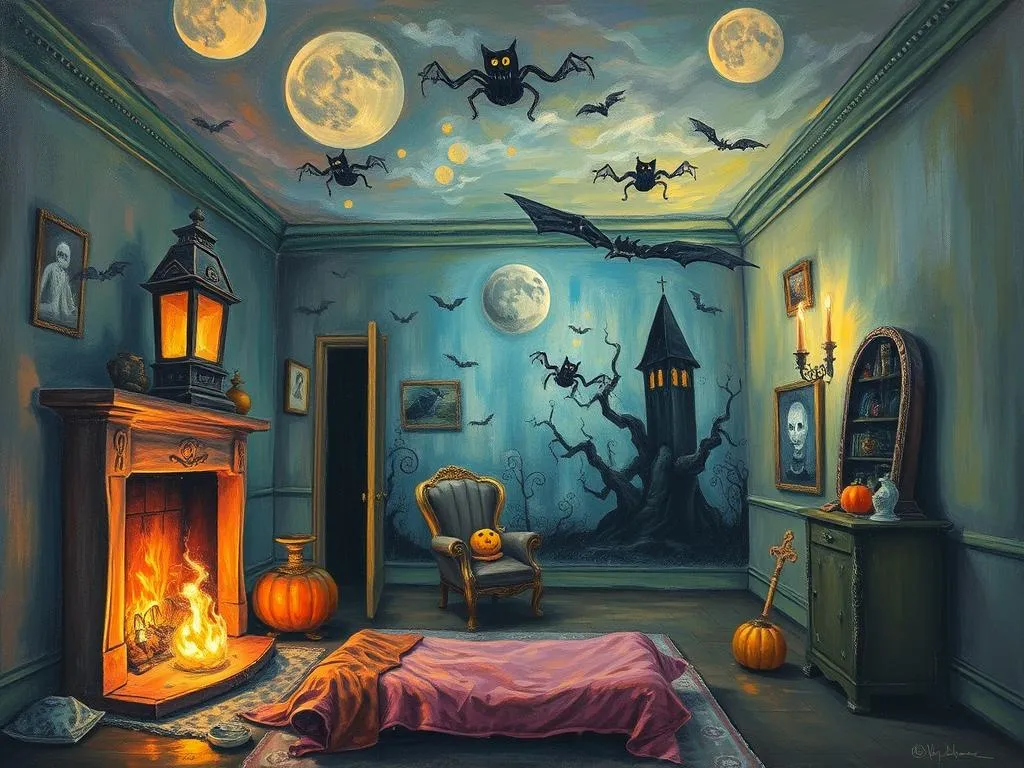
Have you ever woken up from a dream, heart racing, and mind swirling with questions? The unsettling feeling of having wandered through a haunted room in your sleep can linger long after the dream has faded. This experience often leaves us grappling with feelings of fear, confusion, and sometimes even curiosity. What could such a dream mean? Is it a mere reflection of our anxieties, or does it carry deeper symbolism that we should explore?
Dreams of haunted rooms can evoke a spectrum of emotions, from sheer terror to a sense of intrigue. They often serve as a mirror, reflecting our internal struggles, unresolved issues, or even hidden aspects of our personality. By delving into the symbolism, examining scenarios, and considering personal growth opportunities, we can unlock the secrets behind these eerie nocturnal adventures.
Shadows of the Past: Decoding Symbols
When you dream of a haunted room, it’s essential to dissect the symbols that populate this unsettling landscape. The room itself often represents a specific area of your life or a facet of your subconscious. Think of it as a room in the house of your mind, each corner holding memories, fears, or desires.
The haunting aspect typically signifies unresolved emotions or past traumas that linger like ghosts. These specters may represent feelings of guilt, regret, or even fears that refuse to be acknowledged. In many cultures, haunts are seen as manifestations of the past, urging us to confront what we have tried to bury.
Moreover, consider the furniture and objects within the room. Each item may symbolize different experiences or relationships. A broken chair might indicate feelings of instability, while an old mirror might reflect self-image issues. The state of the room—whether it’s cluttered or tidy—can also speak volumes about your mental state.
In various cultures, haunted spaces are viewed as places of transition. For example, in some Indigenous traditions, the spirit world is intertwined with the physical realm, suggesting that our dreams are a bridge between these two worlds. Therefore, encountering a haunted room might be a call to explore your spiritual side, seeking clarity and healing.
Walking Through the Haunting: Your Dream Scenarios
To better understand the haunted room experience, let’s explore several scenarios that many dreamers encounter. Each provides a unique lens through which to view your emotions and thoughts.
Scenario 1: The Locked Room
In this dream, you find yourself in a room that seems familiar yet is locked tight. You can hear whispers or see shadows flickering behind the door. This scenario often points to repressed memories or emotions you’re unwilling to confront. The locked door symbolizes the barriers you’ve put up, protecting yourself from pain. Reflect on what might be hidden behind that door and consider taking steps to confront it.
Scenario 2: The Overwhelming Darkness
Imagine walking into a room so dark that you can barely see your hand in front of your face. This dream signifies feelings of confusion and anxiety in your waking life. The darkness represents uncertainty, fear of the unknown, or even depression. It’s a gentle reminder to seek light—be it through support, therapy, or self-reflection—to navigate your way through the murky waters of your emotions.
Scenario 3: Ghostly Figures
In this haunting experience, you encounter ghostly figures in the room, perhaps resembling people from your past. These spirits might represent unresolved relationships or emotions tied to those individuals. It’s essential to consider what these figures mean to you. Are there conversations left unfinished? Emotions still unexpressed? This dream encourages you to seek closure and heal those old wounds.
Scenario 4: The Room Changes
You enter the room, and as you explore, it transforms—walls shift, objects appear and disappear. This dream reflects your ever-changing emotions and situations in life. It reminds you that change is constant, and it’s okay to feel lost or disoriented. Embrace the transformation and allow yourself to adapt rather than resist the inevitable shifts.
Scenario 5: The Escape
In this final scenario, you manage to escape the haunted room, emerging back into the light. This represents a significant breakthrough in your life. You’ve faced your fears and are ready to embrace change. Celebrate this achievement and use it as motivation to tackle other areas of your life that need attention.
Beyond the Shadows: Embracing Personal Growth
Now that we’ve analyzed the symbols and scenarios, let’s discuss how you can use these dreams as a catalyst for personal growth. A haunted room dream invites you to embark on an introspective journey, allowing you to confront the aspects of yourself that you may have neglected.
1. Acknowledge Your Fears: Start by journaling your thoughts and feelings after experiencing a haunted room dream. Write down the symbols, emotions, and scenarios you encountered. Acknowledging your fears is the first step in confronting them.
2. Seek Closure: If your dream involves ghostly figures, consider reaching out to those from your past. Whether through a letter, conversation, or even a ritual of forgiveness, taking action can help release the emotional weight you carry.
3. Embrace Change: If your dream reflects transformation, remind yourself that change can be a powerful teacher. Consider what aspects of your life need reevaluation and how you can adapt to new circumstances. This might involve setting new goals, seeking new relationships, or letting go of old habits.
4. Explore Your Spiritual Side: Haunted dreams often tap into the spiritual realm. Spend time in meditation, reflecting on your dreams and seeking guidance. This could lead to greater self-awareness and a deeper understanding of your purpose.
5. Reach Out for Support: If the feelings evoked by your haunted room dream are overwhelming, don’t hesitate to seek support from friends, family, or a professional. Sharing your experiences can provide clarity and help you navigate the complexities of your emotions.
Ultimately, dreams—especially those that haunt us—serve as powerful tools for self-discovery. They compel us to look within and confront the shadows that shape our lives. Embrace these dreams as invitations to explore your inner world, and remember that confronting your past is not just an act of bravery; it’s a vital step toward personal transformation.
As you continue on your journey of self-exploration, reflect on this: What if your haunted room is not just a space of fear, but a gateway to healing and growth? The ghosts may linger, but they also offer lessons—lessons that can illuminate your path forward if you dare to face them.







